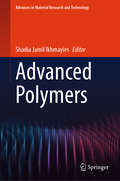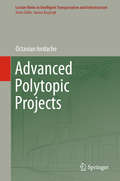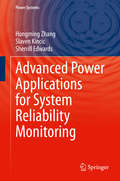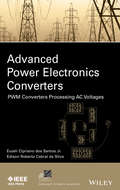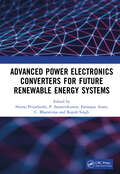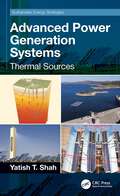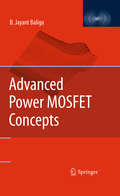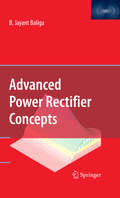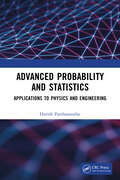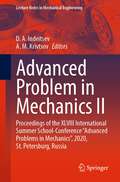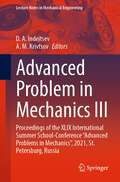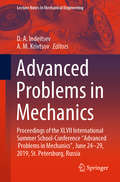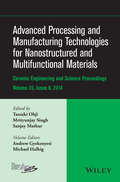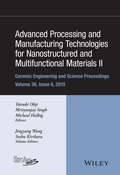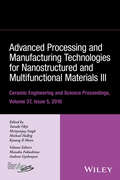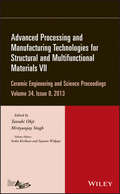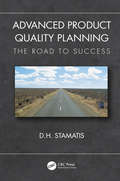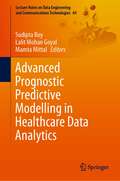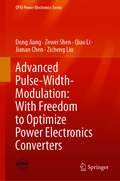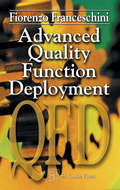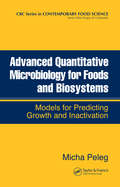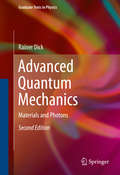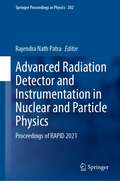- Table View
- List View
Advanced Polymers (Advances in Material Research and Technology)
by Shadia Jamil IkhmayiesThis book delves into a wide array of polymer topics, covering synthesis methods, processing technologies, performances, advanced characterization, and modeling techniques. It highlights recent advancements in polybenzoxazine-based smart shape memory materials, metallopolymer, HCN derived polymers. Advanced polymer composites, polymeric nanomaterials, and their fabrication methods and applications are also discussed. Additionally, the book explores the utilization of emerging polymer materials in biosensor development, covering various classes such as biopolymers, functional polymers, hydrogels, conductive polymers, and nanomaterials. It provides insights into the recent advances in polyaniline copolymers for chemical sensors and cellulose nanocrystals (CNC) and cellulose nanofibers (CNF)-based pickering emulsions with antimicrobial properties, particularly focusing on applications in food and biomedical products. Furthermore, it delves into polydisperse polymer brushes under compression, detailing their behavior concerning polymer persistence length and substrate stiffness.
Advanced Polytopic Projects (Lecture Notes in Intelligent Transportation and Infrastructure)
by Octavian IordacheThis book focuses on new developments in polytopic projects, particularly on implementation domains and case studies, as well as high-dimensional methodology. Polytopic projects are based on a general reference architecture inspired and shared by the functional organization of organisms and enterprises as informational and cognitive systems, the scientific and engineering methodology and the operational structure of existing self-evolvable and self-sustainable systems.
Advanced Power Applications for System Reliability Monitoring (Power Systems)
by Hongming Zhang Sherrill Edwards Slaven KincicThis book examines real-time models and advanced online applications that enhance reliability and resilience of the grid in real-time and near real-time environments. It is written by Peak Reliability engineers who worked on the creation of the West Wide System Model (WSM) and the implementation of advanced real-time operation situational awareness tools for reliability coordination function. The book looks at how a single Reliability Coordinator for the Western Interconnection did its work under normal and emergency conditions, providing a unique perspective on best practices and lessons learned from Peak’s modeling and coordination efforts to create, maintain, and improve state-of-art new technology and algorithms to improve real-time operation situational awareness and Bulk Electric System (BES) grid resilience. Coverage includes practical experience of implementing real-time Energy Management System (EMS) Network Application, real-time voltage stability analysis, online transient stability analysis, synchrophasor technology, Dispatcher Training Simulator and EMS Cybersecurity & Inter-Control Center Communications Protocol (ICCP) implementation experience in a Reliability Coordinator Control Room setting. Explains how to operate a “green” grid and prevent new blackouts against uncertain operation conditions;Written by Peak Reliability engineers who worked on the creation of the West Wide System Model (WWSM);All material verified in practical system operations, or validated by real system measures and system events.
Advanced Power Electronics Converters
by Euzeli Dos Santos Edison R. da SilvaThis book covers power electronics, in depth, by presenting the basic principles and application details, which can be used both as a textbook and reference book.* Introduces a new method to present power electronics converters called Power Blocks Geometry (PBG)* Applicable for courses focusing on power electronics, power electronics converters, and advanced power converters* Offers a comprehensive set of simulation results to help understand the circuits presented throughout the book
Advanced Power Electronics Converters for Future Renewable Energy Systems
by Rajesh Singh P. Sanjeevikumar Neeraj Priyadarshi Farooque Azam C. BharatirajaThis book narrates an assessment of numerous advanced power converters employed on primitive phase to enhance the efficiency of power translation pertaining to renewable energy systems. It presents the mathematical modelling, analysis, and control of recent power converters topologies, namely, AC/DC, DC/DC, and DC/AC converters. Numerous advanced DC-DC Converters, namely, multi-input DC-DC Converter, Cuk, SEPIC, Zeta and so forth have been assessed mathematically using state space analysis applied with an aim to enhance power efficiency of renewable energy systems. The book: Explains various power electronics converters for different types of renewable energy sources Provides a review of the major power conversion topologies in one book Focuses on experimental analysis rather than simulation work Recommends usage of MATLAB, PSCAD, and PSIM simulation software for detailed analysis Includes DC-DC converters with reasonable peculiar power rating This book is aimed at researchers, graduate students in electric power engineering, power and industrial electronics, and renewable energy.
Advanced Power Generation Systems: Thermal Sources (Sustainable Energy Strategies)
by Yatish T. ShahAdvanced Power Generation Systems: Thermal Sources evaluates advances made in heat-to-power technologies for conventional combustion heat and nuclear heat, along with natural sources of geothermal, solar, and waste heat generated from the use of different sources. These advances will render the landscape of power generation significantly different in just a few decades. This book covers the commercial viability of advanced technologies and identifies where more work needs to be done. Since power is the future of energy, these technologies will remain sustainable over a long period of time. Key Features Covers power generation and heat engines Details photovoltaics, thermo-photovoltaics, and thermoelectricity Includes discussion of nuclear and renewable energy as well as waste heat This book will be useful for advanced students, researchers, and professionals interested in power generation and energy industries.
Advanced Power MOSFET Concepts
by B. Jayant BaligaDuring the last decade many new concepts have been proposed for improving the performance of power MOSFETs. The results of this research are dispersed in the technical literature among journal articles and abstracts of conferences. Consequently, the information is not readily available to researchers and practicing engineers in the power device community. There is no cohesive treatment of the ideas to provide an assessment of the relative merits of the ideas. "Advanced Power MOSFET Concepts" provides an in-depth treatment of the physics of operation of advanced power MOSFETs. Analytical models for explaining the operation of all the advanced power MOSFETs will be developed. The results of numerical simulations will be provided to give additional insight into the device physics and validate the analytical models. The results of two-dimensional simulations will be provided to corroborate the analytical models and give greater insight into the device operation.
Advanced Power Rectifier Concepts
by B. Jayant BaligaDuring the last decade, many new concepts have been proposed for improving the performance of power rectifiers and transistors. The results of this research are dispersed in the technical literature among journal articles and abstracts of conferences. Consequently, the information is not readily available to researchers and practicing engineers in the power device community. There is no cohesive treatment of the ideas to provide an assessment of the relative merits of the ideas. Advanced Power Rectifier Concepts provides an in-depth treatment of the physics of operation of advanced power rectifiers. Analytical models for explaining the operation of all the advanced power rectifier devices will be developed. The results off numerical simulations will be provided to provide additional insight into the device physics and validate the analytical models. The results of two-dimensional simulations will be provided to corroborate the analytical models and provide greater insight into the device operation.
Advanced Probability and Statistics: Applications to Physics and Engineering
by Harish ParthasarathyThis book surveys some of the important research work carried out by Indian scientists in the field of pure and applied probability, quantum probability, quantum scattering theory, group representation theory and general relativity. It reviews the axiomatic foundations of probability theory by A.N. Kolmogorov and how the Indian school of probabilists and statisticians used this theory effectively to study a host of applied probability and statistics problems like parameter estimation, convergence of a sequence of probability distributions, and martingale characterization of diffusions. It will be an important resource to students and researchers of Physics and Engineering, especially those working with Advanced Probability and Statistics.
Advanced Problem in Mechanics II: Proceedings of the XLVIII International Summer School-Conference “Advanced Problems in Mechanics”, 2020, St. Petersburg, Russia (Lecture Notes in Mechanical Engineering)
by D. A. Indeitsev A. M. KrivtsovThis book focuses on original theories and approaches in the field of mechanics. It reports on both theoretical and applied researches, with a special emphasis on problems and solutions at the interfaces of mechanics and other research areas. The respective chapters highlight cutting-edge works fostering development in fields such as micro- and nanomechanics, material science, physics of solid states, molecular physics, astrophysics, and many others. Special attention has been given to outstanding research conducted by young scientists from all over the world. This book is based on the 48th edition of the international conference “Advanced Problems in Mechanics”, which was held in 2020, in St. Petersburg, Russia, and co-organized by The Peter the Great St. Petersburg Polytechnic University and the Institute for Problems in Mechanical Engineering of the Russian Academy of Sciences, under the patronage of the Russian Academy of Sciences. It provides researchers and graduate students with an extensive overview of the latest research and a source of inspiration for future developments and collaborations in mechanics and related fields.
Advanced Problem in Mechanics III: Proceedings of the XLIX International Summer School-Conference “Advanced Problems in Mechanics”, 2021, St. Petersburg, Russia (Lecture Notes in Mechanical Engineering)
by D. A. Indeitsev A. M. KrivtsovThis book focuses on original theories and approaches in the field of mechanics. It reports on both theoretical and applied researches, with a special emphasis on problems and solutions at the interfaces of mechanics and other research areas. The respective chapters highlight cutting-edge works fostering development in fields such as micro- and nanomechanics, material science, physics of solid states, molecular physics, astrophysics, and many others. Special attention has been given to outstanding research conducted by young scientists from all over the world. This book is based on the 49th edition of the international conference “Advanced Problems in Mechanics”, which was held on June 21-25, 2021, in St. Petersburg, Russia, and co-organized by The Peter the Great St. Petersburg Polytechnic University and the Institute for Problems in Mechanical Engineering of the Russian Academy of Sciences, under the patronage of the Russian Academy of Sciences. It provides researchers and graduate students with an extensive overview of the latest research and a source of inspiration for future developments and collaborations in mechanics and related fields.
Advanced Problems in Mechanics: Proceedings of the XLVII International Summer School-Conference “Advanced Problems in Mechanics”, June 24-29, 2019, St. Petersburg, Russia (Lecture Notes in Mechanical Engineering)
by D. A. Indeitsev A. M. KrivtsovThis book focuses on original theories and approaches in the field of mechanics. It reports on both theoretical and applied research, with a special emphasis on problems and solutions at the interfaces of mechanics and other research areas. The respective chapters highlight cutting-edge works fostering development in fields such as micro- and nanomechanics, material science, physics of solid states, molecular physics, astrophysics, and many others. Special attention has been given to outstanding research conducted by young scientists from all over the world. Based on the 47th edition of the international conference “Advanced Problems in Mechanics”, held on June 24–29, 2019, in St. Petersburg, Russia, and organized by Peter the Great St. Petersburg Polytechnic University and Institute for Problems in Mechanical Engineering of Russian Academy of Sciences under the patronage of Russian Academy of Sciences, the book provides researchers and graduate students with an extensive overview of the latest research and a source of inspiration for future developments in various fields of mechanics.
Advanced Process Control
by Cecil L. SmithThis book fills the gap between basic control configurations (Practical Process Control) and model predictive control (MPC). For those loops whose performance has a direct impact on plant economics or product quality, going beyond simple feedback or cascade can improve control performance, or specifically, reduce the variance about the target. However, the effort required to implement such control technology must be offset by increased economic returns from production operations. The economic aspects of the application of the various advanced control technologies are stressed throughout the book.
Advanced Processing and Manufacturing Technologies for Nanostructured and Multifunctional Materials
by Sanjay Mathur Mrityunjay Singh Tatsuki Ohji Andrew L. Gyekenyesi American Ceramics Society Michael HalbigOver 170 contributions (invited talks, oral presentations, and posters) were presented by participants from universities, research institutions, and industry, which offered interdisciplinary discussions indicating strong scientific and technological interest in the field of nanostructured systems. This issue contains 23 peer-reviewed papers that cover various aspects and the latest developments related to nanoscaled materials and functional ceramics.
Advanced Processing and Manufacturing Technologies for Nanostructured and Multifunctional Materials II
by Mrityunjay Singh Tatsuki Ohji Soshu Kirihara Jingyang Wang Michael HalbigOver 170 contributions (invited talks, oral presentations, and posters) were presented by participants from universities, research institutions, and industry, which offered interdisciplinary discussions indicating strong scientific and technological interest in the field of nanostructured systems. This issue contains 23 peer-reviewed papers that cover various aspects and the latest developments related to nanoscaled materials and functional ceramics.
Advanced Processing and Manufacturing Technologies for Nanostructured and Multifunctional Materials III
by Mrityunjay Singh Tatsuki Ohji Michael Halbig Kyoung Il Moon Manabu Fukushima Andrew GyekenyesiThis issue contains 9 papers from The American Ceramic Society’s 40th International Conference on Advanced Ceramics and Composites, held in Daytona Beach, Florida, January 24-29, 2016. This issue includes papers presented in the 10th International Symposium on Advanced Processing and Manufacturing Technologies for Structural and Multifunctional Materials and Systems (Symposium 8), Additive Manufacturing and 3D Printing Technologies (Focused Session 4), and Field Assisted Sintering (Focused Session 5).
Advanced Processing and Manufacturing Technologies for Structural and Multifunctional Materials VII: Ceramic Engineering and Science Proceedings, Volume 34 Issue 8
by Mrityunjay Singh Tatsuki Ohji Soshu Kirihara Sujanto WidjajaCeramic Engineering and Science Proceedings Volume 34, Issue 8 - Advanced Processing and ManufacturingTechnologies for Structural and Multifunctional Materials VIIA collection of 20 papers from The American Ceramic Society's 37th International Conference on Advanced Ceramics and Composites, held in Daytona Beach, Florida, January 27-February 1, 2013. This issue includes papers presented in the 7th International Symposium on Advanced Processing and Manufacturing Technologies for Structural and Multifunctional Materials and Systems (Symposium 8).
Advanced Product Quality Planning: The Road to Success (Practical Quality of the Future)
by D. H. StamatisThis book defines, develops, and examines the foundations of the APQP (Advanced Product Quality Planning) methodology. It explains in detail the five phases, and it relates its significance to national, international, and customer specific standards. It also includes additional information on the PPAP (Production Part Approval Process), Risk, Warranty, GD&T (Geometric Dimensioning and Tolerancing), and the role of leadership as they apply to the continual improvement process of any organization. Features Defines and explains the five stages of APQP in detail Identifies and zeroes in on the critical steps of the APQP methodology Covers the issue of risk as it is defined in the ISO 9001, IATF 16949, the pending VDA, and the OEM requirements Presents the role of leadership and management in the APQP methodology Summarizes all of the change requirements of the IATF standard
Advanced Prognostic Predictive Modelling in Healthcare Data Analytics (Lecture Notes on Data Engineering and Communications Technologies #64)
by Mamta Mittal Lalit Mohan Goyal Sudipta RoyThis book discusses major technical advancements and research findings in the field of prognostic modelling in healthcare image and data analysis. The use of prognostic modelling as predictive models to solve complex problems of data mining and analysis in health care is the feature of this book. The book examines the recent technologies and studies that reached the practical level and becoming available in preclinical and clinical practices in computational intelligence. The main areas of interest covered in this book are highest quality, original work that contributes to the basic science of processing, analysing and utilizing all aspects of advanced computational prognostic modelling in healthcare image and data analysis.
Advanced Pulse-Width-Modulation: With Freedom to Optimize Power Electronics Converters (CPSS Power Electronics Series)
by Qiao Li Zicheng Liu Dong Jiang Zewei Shen Jianan ChenThis book is a technical publication for students, scholars and engineers in electrical engineering, focusing on the pulse-width-modulation (PWM) technologies in power electronics area. Based on an introduction of basic PWM principles this book analyzes three major challenges for PWM on system performance: power losses, voltage/current ripple and electromagnetic interference (EMI) noise, and the lack of utilization of control freedoms in conventional PWM technologies. Then, the model of PWM's impact on system performance is introduced, with the current ripple prediction method for voltage source converter as example. With the prediction model, two major advanced PWM methods are introduced: variable switching frequency PWM and phase-shift PWM, which can reduce the power losses and EMI for the system based on the prediction model. Furthermore, the advanced PWM can be applied in advanced topologies including multilevel converters and paralleled converters. With more control variables in the advanced topologies, performance of PWM can be further improved. Also, for the special problem for common-mode noise, this book introduces modified PWM method for reduction. Especially, the paralleled inverters with advanced PWM can achieve good performance for the common-mode noise reduction. Finally, the implementation of PWM technologies in hardware is introduced in the last part.
Advanced Quality Function Deployment
by Fiorenzo FranceschiniA versatile manual that can be used to stimulate product innovation, benchmarking analysis, and engineering design, this book goes beyond theory to provide relevant advanced methods and techniques that readers can apply in their work for both short- and long-term results. The author links Quality Function Deployment (QFD) with other quality design techniques and discusses processes for improving its effectiveness. He also highlights methods for selecting a product's technical features. Real implementation case studies and numerous examples illustrate the concepts, including the Qualitometro method for designing and measuring quality in the service sector.
Advanced Quantitative Microbiology for Foods and Biosystems: Models for Predicting Growth and Inactivation
by Micha PelegPresenting a novel view of the quantitative modeling of microbial growth and inactivation patterns in food, water, and biosystems, Advanced Quantitative Microbiology for Foods and Biosystems: Models for Predicting Growth and Inactivation describes new models for estimating microbial growth and survival. The author covers traditional and alte
Advanced Quantum Mechanics: Materials and Photons (Graduate Texts in Physics)
by Rainer DickAdvanced Quantum Mechanics: Materials and Photons is a textbook which emphasizes the importance of advanced quantum mechanics for materials science and all experimental techniques which employ photon absorption, emission, or scattering. Important aspects of introductory quantum mechanics are covered in the first seven chapters to make the subject self-contained and accessible for a wide audience. The textbook can therefore be used for advanced undergraduate courses and introductory graduate courses which are targeted towards students with diverse academic backgrounds from the Natural Sciences or Engineering. To enhance this inclusive aspect of making the subject as accessible as possible, Appendices A and B also provide introductions to Lagrangian mechanics and the covariant formulation of electrodynamics. Other special features include an introduction to Lagrangian field theory and an integrated discussion of transition amplitudes with discrete or continuous initial or final states. Once students have acquired an understanding of basic quantum mechanics and classical field theory, canonical field quantization is easy. Furthermore, the integrated discussion of transition amplitudes naturally leads to the notions of transition probabilities, decay rates, absorption cross sections and scattering cross sections, which are important for all experimental techniques that use photon probes. Quantization is first discussed for the Schrödinger field before the relativistic Maxwell, Klein-Gordon and Dirac fields are quantized. Quantized Schrödinger field theory is not only important for condensed matter physics and materials science, but also provides the easiest avenue to general field quantization and is therefore also useful for students with an interest in nuclear and particle physics. The quantization of the Maxwell field is performed in Coulomb gauge. This is the appropriate and practically most useful quantization procedure in condensed matter physics, chemistry, and materials science because it naturally separates the effects of Coulomb interactions, exchange interactions, and photon scattering. The appendices contain additional material that is usually not found in standard quantum mechanics textbooks, including a completeness proof of eigenfunctions of one-dimensional Sturm-Liouville problems, logarithms of matrices, and Green's functions in different dimensions.
Advanced Quantum Mechanics: Materials and Photons (Graduate Texts in Physics)
by Rainer DickThis textbook, now in an expanded third edition, emphasizes the importance of advanced quantum mechanics for materials science and all experimental techniques which employ photon absorption, emission, or scattering. Important aspects of introductory quantum mechanics are covered in the first seven chapters to make the subject self-contained and accessible for a wide audience. Advanced Quantum Mechanics: Materials and Photons can therefore be used for advanced undergraduate courses and introductory graduate courses which are targeted towards students with diverse academic backgrounds from the Natural Sciences or Engineering. To enhance this inclusive aspect of making the subject as accessible as possible, introductions to Lagrangian mechanics and the covariant formulation of electrodynamics are provided in appendices. This third edition includes 60 new exercises, new and improved illustrations, and new material on interpretations of quantum mechanics. Other special features include an introduction to Lagrangian field theory and an integrated discussion of transition amplitudes with discrete or continuous initial or final states. Once students have acquired an understanding of basic quantum mechanics and classical field theory, canonical field quantization is easy. Furthermore, the integrated discussion of transition amplitudes naturally leads to the notions of transition probabilities, decay rates, absorption cross sections and scattering cross sections, which are important for all experimental techniques that use photon probes.
Advanced Radiation Detector and Instrumentation in Nuclear and Particle Physics: Proceedings of RAPID 2021 (Springer Proceedings in Physics #282)
by Rajendra Nath PatraThe RAPID2021 workshop focused on a specific and contemporary research topic: detector technology and electronics for nuclear and particle physics experiments as well as applications. In the RAPID2021, we had invited lectures, overview talks and contributed presentations by the scientists and young researchers from all around the world. In this workshop the papers presented are on the new developments at different experiments (ALICE, CMS, ATLAS) at CERN, new micro-pattern gas detectors development by RD51 collaboration at CERN, development of silicon pixel sensors at CERN, detectors for FAIR facilities in Germany, low energy experiments at different facilities, new detector ideas for nuclear and particle physics experiments, developments in electronics to overcome the challenges for the future LHC experiments, and application of the detectors on medical imaging. The proceedings of the workshop are quite helpful to document the new results, technologies, and developments by different groups and well known international laboratories like CERN, GSI, and Brookhaven National Laboratory. The publication of the scientists and young researchers will definitely be the new references for future studies on the same direction.
